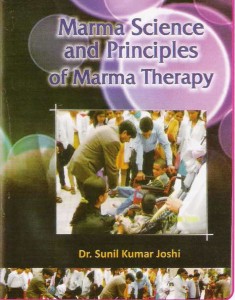This book, of 120 pages, with profuse illustrations, was published in August 2010 by Vani Publications, Delhi, in association with Mrityunjay Mission, Haridwar.
The book, Marma Science and Principles of Marma Therapy, is based on several years of research by Dr Joshi, both practical research and academic research in Matma Science. The academic research includes ancient texts as well and practical research is based on treatment of thousands of patients over the last 20 years, and brings to the contemporary world a method of treatment which is a non-medicinal and non-surgical intervention.
 The cover page shows Dr Joshi treating a disabled child in a demonstration mode to anumber of students. This photo is surrounded by coloured circles, visualising the universal energies that are present in the individual and get invoked/stimulated during marma therapy. This congruence of energies is a very important dimension in the entire book, though a large part of the book is concerned with mundane aspect of therapy. So it is not simply a medical book, but also has religious/spiritual dimensions.
The cover page shows Dr Joshi treating a disabled child in a demonstration mode to anumber of students. This photo is surrounded by coloured circles, visualising the universal energies that are present in the individual and get invoked/stimulated during marma therapy. This congruence of energies is a very important dimension in the entire book, though a large part of the book is concerned with mundane aspect of therapy. So it is not simply a medical book, but also has religious/spiritual dimensions.
The Preface is usually not read by many people. However it contains a core and important message of the book, which is an overwhelming statement about the self-healing powers inherent in man, which the therapy is only activating. In the modern times this is a heartening and unknown message.
The book is divided into four sections.
The first section deals with the historical basis of Marma science in the Sushruta Samhita, its definition and fundamentals, classifications according to different criteria like location of points in the human body, the body constituents of marma points and their properties etc. The basic sketch of some important points in the body is in this section.
The second section is the main body of therapy and deals with different techniques and methods of marma therapy in various diseases, the precautions to be followed, and the use of marma therapy in psychological conditions and management of pain.There follows a chapter on self-marma, a regular practice that can be adopted like Yoga practice, to prevent disease, maintain and promote health, both mental and physical, through daily re-energising through stimulating the marma points. This supports the second objective of Ayurveda, that is, not only to cure disease, but to maintain health in the healthy.
The third section reveals what is little known, — that stimulation of marma points is inherent in all Yogic practice, including asanas, pranayama and mudras. However, the section goes into detail about 11 to 12 asanas, what are the marma points involved in them, and how when sometimes the performance of the asanas are contraindicated, the marma therapy involved in them may still be continued for the same benefits.
The last section is brief but important as it compares Marma science with some popular eastern therapies like accupressure, in its similarities and differences. The concluding chapter in this section points to the evidence of the knowledge of Marma science even in the Ramayana/Mahabharata and hopes that this knowledge may be revived and used as widely as possible for human welfare.
The symbol of Mrityunjay Mission appears on the title page and on every section separator and depicts Mrityunjay, the healing aspect of Shiva.
It is to be remembered that this book is not a manual but an initial exposure of contemporary research on an ancient medical science. It will engage doctors of any discipline, para- medical persons engaged in alternative therapies and Yogic practices, as well as lay people interested in health.
